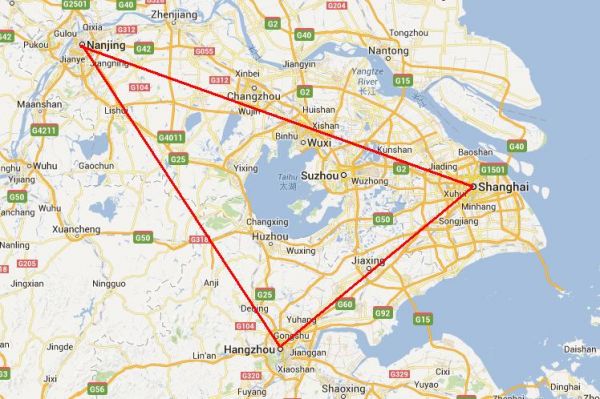The Yangtze Delta Iron Triangle
- Details
- Category: Ningbo News
- Published: Wednesday, 19 June 2013 09:09
On the west shore of Taihu Lake in Yixing (宜兴), Jiangsu, Cheng Chao (程超) sits clasping a purple clay tea pot as he looks on at the misty Hengshan (横山) Reservoir with anticipation.
Within just the past few years, resorts and convention centers have sprouted up around the reservoir playing on the area’s well-known Dajue Temple. It’s all part of a drive to build the Yunhu (云湖) scenic area in preparation for the new Nanjing-Hangzhou high-speed railway.
Cheng Chao owns a tea house in Hangzhou and now he’s planning on opening a branch in Yunhu in order to get closer to Yixing’s tea plantations and resources. But more importantly, he believes that after the Nanjing-Hangzhou high-speed railway opens at the end of June, Yixing, which lies right between the two cities, will become a very popular tourist destination.
In preparation for the railway, the city of Yixing has also invested 250 million yuan in the Shanjuandong (善卷洞) and Yangxian (阳羡) eco-tourism scenic areas. Local leaders believe that it will be the perfect getaway for Shanghai, Nanjing and Hangzhou residents who were previously unable to conveniently travel to the city.
Yixing isn’t the only city expecting big changes from the new railway. It will complete what’s been deemed the “Iron Triangle” of high-speed transport in the Yangtze River Delta. Shanghai, Hangzhou and Nanjing will be connected, and soon after will be joined by Ningbo.
Liu Zhibiao (刘志彪), head of the Jiangsu Provincial Academy of Social Science, says that opening the Nanjing-Hangzhou line will strengthen Nanjing and Hangzhou’s economic activity in the short term and further improve Shanghai’s status as the center of the Yangtze River Delta region in the long-term.
The “Weak Side” of the Triangle
As far back as the early 1990s, Yixing had planned to raise funds for a passenger railway line. However, this railway eventually became a freight line instead. And although Yixing had a developed road network, it didn’t provide the convenience needed to transport large numbers of people. This has presented an obstacle for the city’s development.
In fact, the whole area between Nanjing and Hangzhou has remained relatively underdeveloped because of transportation issues, making it the “weak side” of the Iron Triangle. This area includes the cities of Yixing, Huzhou (湖州), Liyang (溧阳) and Jurong (句容), as well as the five counties of Lishui (溧水), Gaochun (高淳), Changxing (长兴), Anji (安吉) and Deqing (德清). There are also 283 smaller towns in the area.
In 2004, the area between Nanjing and Hangzhou accounted for 34 and 23 percent of the population and land area in the Yangtze River Delta respectively. However, its GDP and fiscal revenue accounted for just 20 and 14 percent respectively, demonstrating that its economic performance has been lower than average for the region.
Shi Jinchuan (史晋川), director of the social sciences department of Zhejiang University, says that the Yangtze River Delta region has always had the structure of a “V-shape,” confining most economic interaction between the two cities and Shanghai, but not with one another. Now that the railway will turn the V-shape into a triangle, Nanjing and Hangzhou will become closer economically and drive new industries. Zhang Zhaoan (张兆安), vice chairman of the Shanghai Committee of China National Democratic Construction Association,says that human resources, technology, logistics and information industries all stand to benefit.
On Yixing’s online forums, residents have been talking about what businesses might gain after the railway opens. One resident surnamed Zhang is banking on business picking up for his car rental company after the line brings an influx of travelers.
The tourism industry may indeed become the first beneficiary of the new line. When it opens, it will only take half an hour to get from Yixing to Nanjing or Hangzhou. Some local tourism companies have already formed agreements with agencies in the two cities. Outside of Yixing, there are also tourism hotspots like the Grand Canal, Tianmu Lake and West Lake that are expecting a new surge in visitors.
Shanghai’s Status
The new Nanjing-Hangzhou line will undoubtedly divert passengers who previously had to transit through Shanghai. But Zhang Zhaoan believes that in the long-term, this is also an opportunity for Shanghai’s development as the region’s flagship city.
In the future, high-speed railway services will be increased between Shanghai and other cities, making everyone more interconnected. Currently, there’s about one train leaving for Shanghai from Hangzhou every 50 minutes during peak periods. That frequency will be increased in the future, making the Iron Triangle’s other nickname - “the one hour economic circle” – a reality.
Zhou Hongyun (周红云), deputy director and engineer at the Shanghai Railway Bureau, reported that the construction of the high-speed railway network in the Yangtze River Delta region will speed up and reach 3,200 kilometers of track by 2015.










